Kure Atoll is a small coral reef located in the Northwestern Hawaiian Islands. Despite its small size, the atoll is an important habitat for a variety of birds, with approximately 16 species found on the island.
Kure Atoll’s location on the Pacific Flyway provides a crucial rest stop for birds during their long migratory journeys and has been designated as one of the United States’ most important seabird breeding sites. Additionally, the atoll’s isolation from human settlement and activity has allowed for the preservation of its unique ecosystem and the bird species that call it home.
In this article, we will delve deeper into the different bird species living on Kure Atoll, examining their unique characteristics and behaviors, as well as the important role they play in the atoll’s ecosystem.
1. Northern Storm Petrels
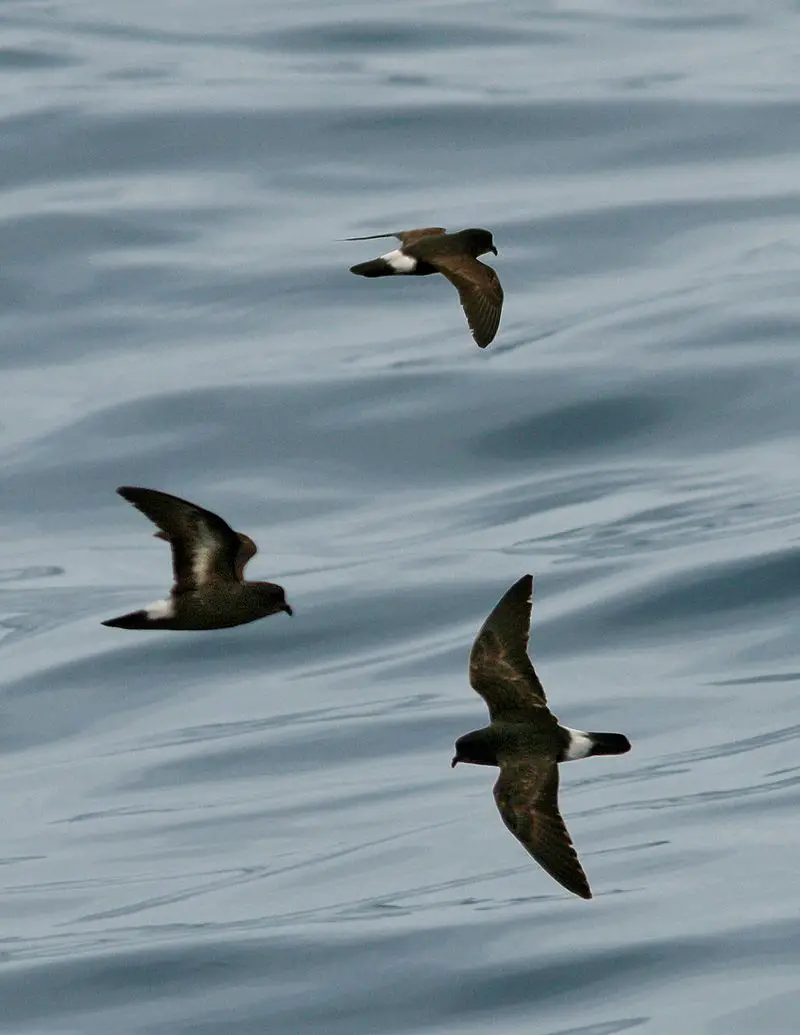
Northern storm petrels are one of the smallest seabirds, inhabiting oceans all over the world.
They have a unique ability to hover over water and pick planktonic crustaceans and small fish from the surface.
Northern storm petrels belong to the genus Hydrobates in family Hydrobatidae, part of Procellariiformes order.
This species was once lumped with austral storm petrel but recent studies show that they weren’t related closely which led them being split into two distinct species now.
These birds can be identified by their dark grey upperparts and wings along with white underparts when seen from afar while feeding on ocean’s surface.Scientific classification:
| Kingdom | Animalia |
| Phylum | Chordata |
| Class | Aves |
| Order | Procellariiformes |
| Family | Hydrobatidae Mathews, 1912 |
| Genus | Hydrobates F. Boie, 1822 |
Also Featured In: Beautiful Brazilian Birds, Birds of Sweden
2. Brown Booby
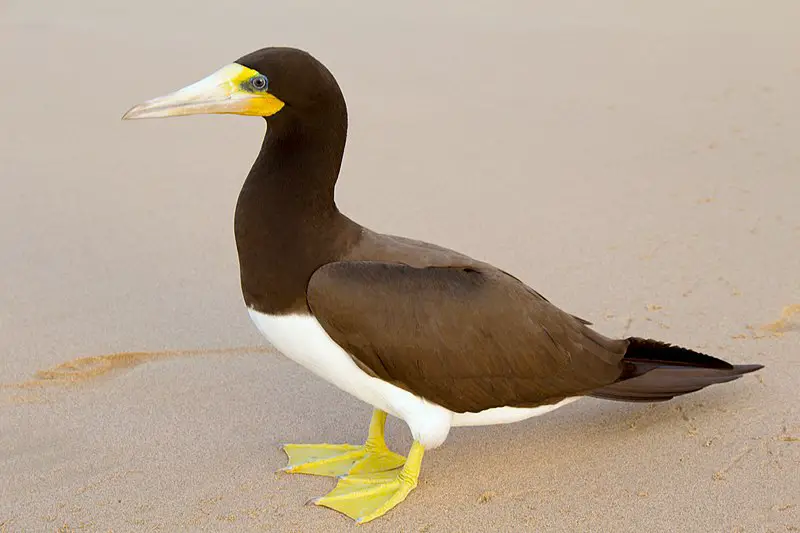
The Brown Booby is a large, seabird from the booby family Sulidae. It has a pantropical range and can be found in many areas of the world.
This bird lives in flocks and forages by plunging into shallow waters to catch small fish that are driven near the surface by predators or storms.
The brown booby is known for its short wings which make it highly maneuverable when hunting; this allows it to pursue prey quickly with sudden turns and dives.
Its diet also includes squid, crustaceans, eggs of other birds, as well as scraps from boats or ships they may come across while flying around coastlines.
They sometimes rest on floating objects during their long flights over open water between islands or continents.Scientific classification:
| Kingdom | Animalia |
| Phylum | Chordata |
| Class | Aves |
| Order | Suliformes |
| Family | Sulidae |
| Genus | Sula |
| Species | S. leucogaster |
Also Featured In: Egyptian Birds, Birds that You’ll Find in Puerto Rico
3. Arctic Tern
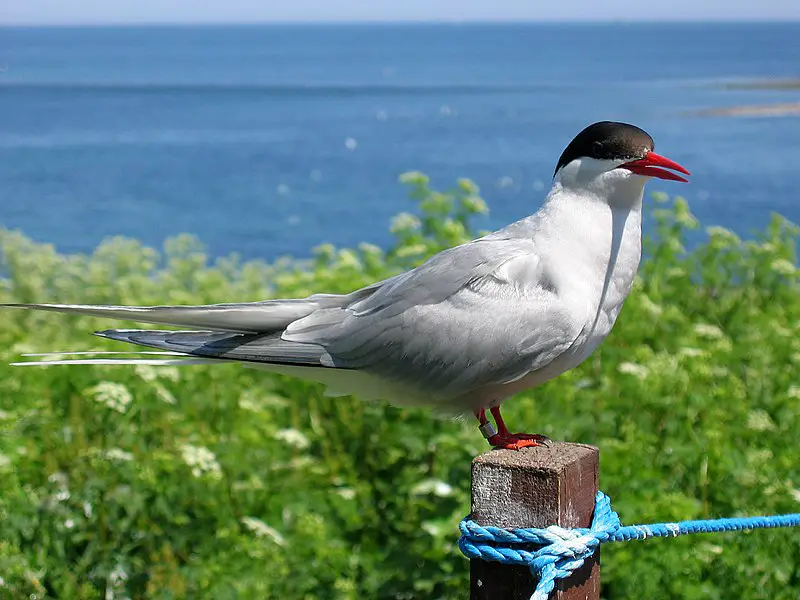
The Arctic tern is an incredible bird that displays a truly remarkable migratory behavior.
It breeds in the northern regions of Europe, Asia and North America during summer before undertaking its migration along a convoluted route to reach the Antarctic for winter.
This species has adapted extremely well to its environment – it can fly very long distances while navigating with ease thanks to their excellent eyesight.
Furthermore, they are able to survive in temperatures as low as -40 degrees Celsius.
The Arctic Tern is also known for being one of the longest living birds on Earth; some have been recorded living up to 30 years old.Scientific classification:
| Kingdom | Animalia |
| Phylum | Chordata |
| Class | Aves |
| Order | Charadriiformes |
| Family | Laridae |
| Genus | Sterna |
| Species | S. paradisaea |
Also Featured In: Birds of United Kingdom, Most Common Scotland Birds
4. Frigatebird
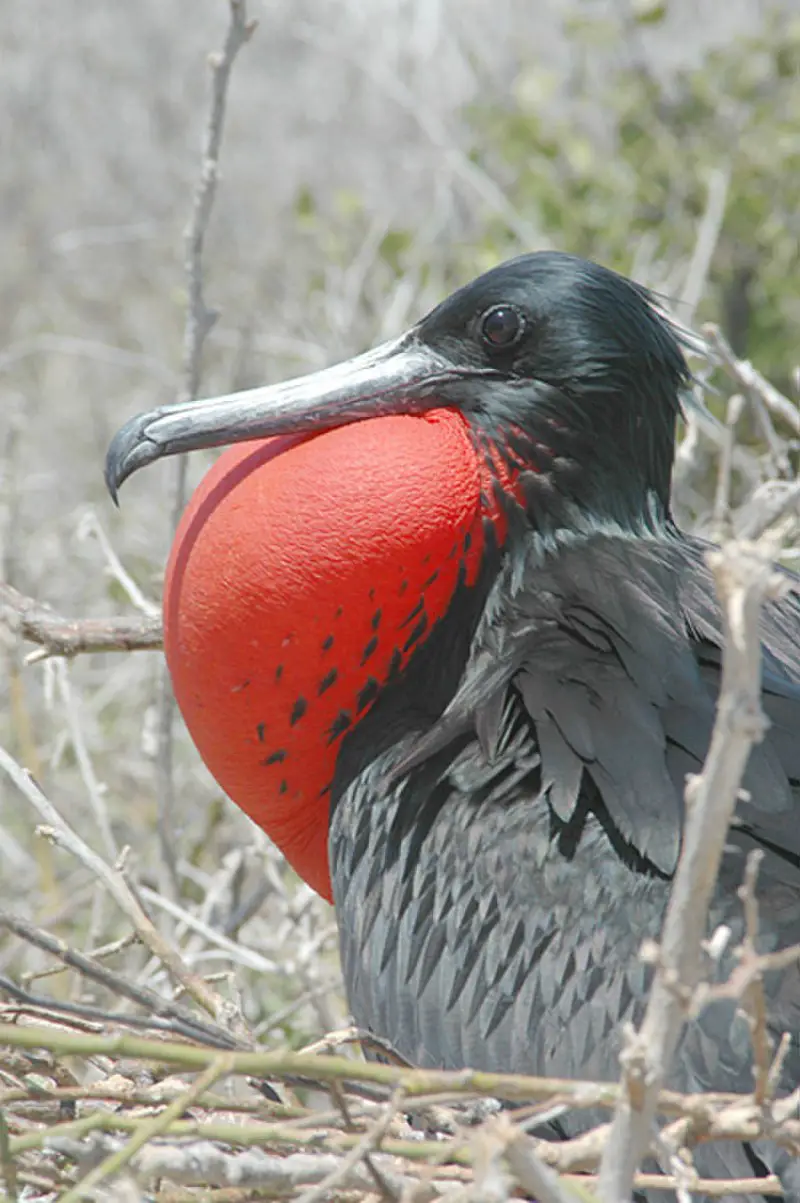
Frigatebirds are a beautiful and mysterious family of seabirds, found in all tropical and subtropical oceans. The five extant species have glossy black plumage, long forked tails, and lengthy hooked bills.
During the breeding season males display a bright red gular pouch which they inflate to attract mates. Females have white underbellies year-round giving them an elegant contrast against their darker feathers.
They spend most of their lives soaring with minimal effort over warm ocean waters seeking food such as fish or squid taken from the surface or plucked out of midair by other birds.
Frigatebirds often nest on isolated islands due to lack of predators yet still manage to travel incredibly large distances between feeding grounds every day making them truly remarkable creatures.Scientific classification:
| Kingdom | Animalia |
| Phylum | Chordata |
| Class | Aves |
| Order | Suliformes |
| Family | Fregatidae Degland & Gerbe, 1867 |
| Genus | Fregata Lacépède, 1799 |
Also Featured In: Birds of Ecuador, Flocks Birds around Us
5. Common Tern
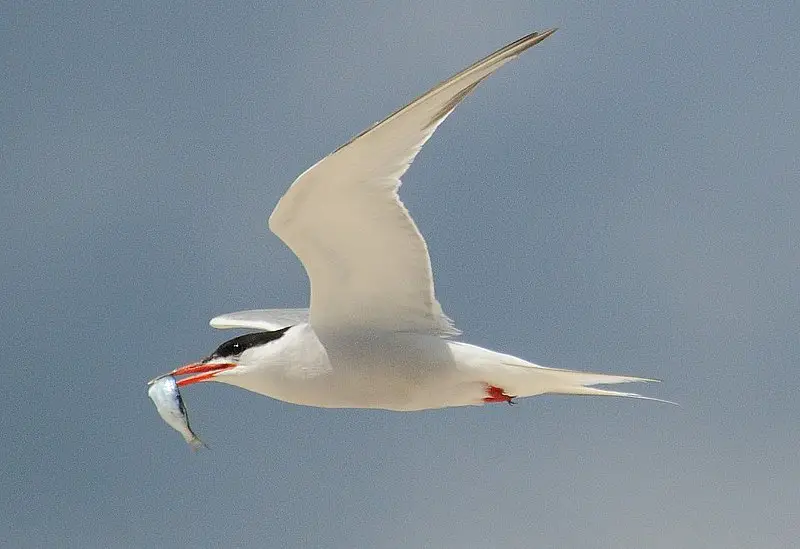
The Common Tern is a seabird in the Laridae family, found all over Europe, Asia and North America. It has a migratory nature, spending its winters in coastal tropical and subtropical regions.
Breeding adults have light grey upperparts with white to very light grey underparts featuring an orange-red beak and black cap.
They are known for their graceful flight as they hunt small fish or insects by diving into water from great heights.
During breeding season they build nests together on islands or sandbars using grasses and other materials to create them.
The female will lay two eggs which she incubates while her mate stands guard nearby; both parents take turns feeding the chicks until it’s time for them fly away.Scientific classification:
| Kingdom | Animalia |
| Phylum | Chordata |
| Class | Aves |
| Order | Charadriiformes |
| Family | Laridae |
| Genus | Sterna |
| Species | S. hirundo |
Also Featured In: Birds of Netherlands, Flight Birds You Should Know
6. Albatrosses
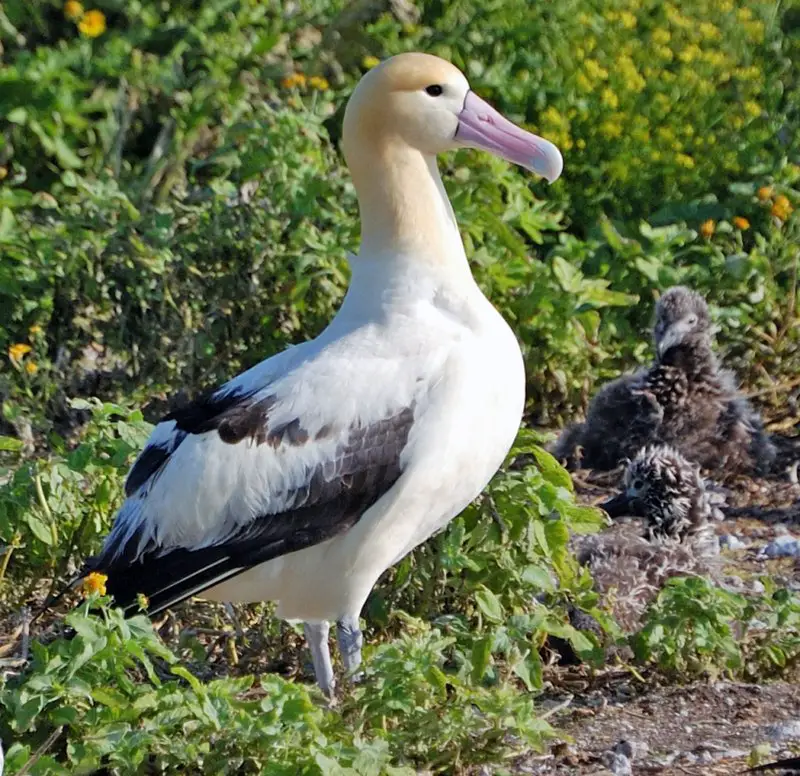
Albatrosses are majestic, large seabirds belonging to the Diomedeidae family in the Procellariiformes order.
These birds have an impressive wingspan and can fly great distances over oceans with minimal effort.
They inhabit all of the world’s southern oceans, ranging from Antarctica up through New Zealand and Australia as well as parts of the northern Pacific Ocean region.
Albatross populations were once abundant throughout much of their range but they now face threats such as longline fishing gear entanglement which has caused a significant decline in numbers in some areas.
Furthermore, occasional vagrants have been found outside their native ranges including fossil remains suggesting that albatrosses previously existed on other regions too.Scientific classification:
| Kingdom | Animalia |
| Phylum | Chordata |
| Class | Aves |
| Order | Procellariiformes |
| Family | Diomedeidae G.R. Gray 1840[1] |
Also Featured In: New Zealand Birds, Galapagos Birds You Should Know
7. Brown Noddy
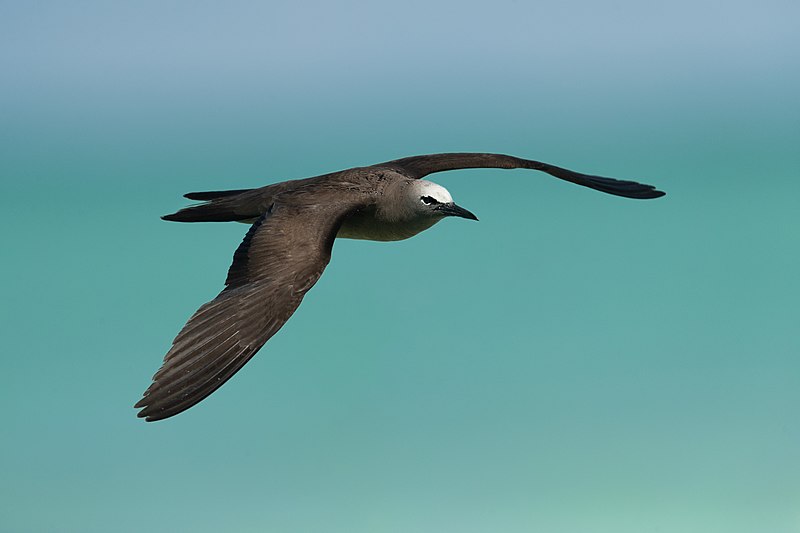
The Brown Noddy is a species of seabird in the Laridae family. It’s the largest of its kind, and can be distinguished from others by its dark brown plumage, which stands out compared to other noddies with black feathers.
Found around tropical oceans worldwide, it inhabits areas such as Hawaii and Australia all the way to Tuamotu Archipelago in Polynesia.
During breeding season they form large colonies on remote islands where their nests are constructed using twigs and leaves situated atop trees or shrubs – typically located near water sources like lagoons or estuaries so they have access to food items like small fish and squid that make up their diet.
As highly social birds they often engage in synchronised flying displays over nesting sites before returning back home at nightfall.Scientific classification:
| Kingdom | Animalia |
| Phylum | Chordata |
| Class | Aves |
| Order | Charadriiformes |
| Family | Laridae |
| Genus | Anous |
| Species | A. stolidus |
Also Featured In: Mauritius birds, Brown Birds of Florida
8. Red-Footed Booby
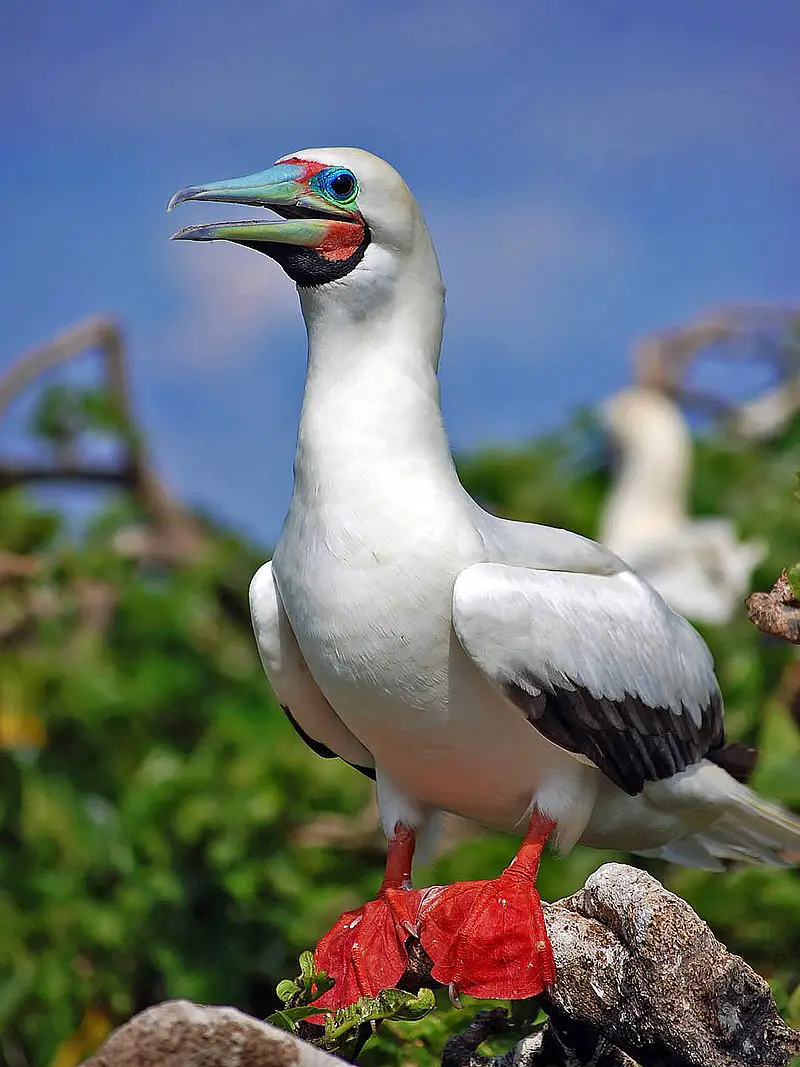
The Red-footed Booby is a large seabird of the Sulidae family, easily distinguished by its bright red feet. These birds are strong and agile fliers but can be clumsy in takeoffs and landings.
They live mostly in tropical areas and breed colonially on coastal islands all over the world.
The species faces few threats from either nature or humans, however their population has decreased slightly due to disturbances near breeding sites.
Despite this mild decline, they remain an incredibly common sight across many parts of the tropics – so much so that they have become symbolic with island life.Scientific classification:
| Kingdom | Animalia |
| Phylum | Chordata |
| Class | Aves |
| Order | Suliformes |
| Family | Sulidae |
| Genus | Sula |
| Species | S. sula |
Also Featured In: Cabo Verde birds, Caribbean Birds
9. Sooty Tern
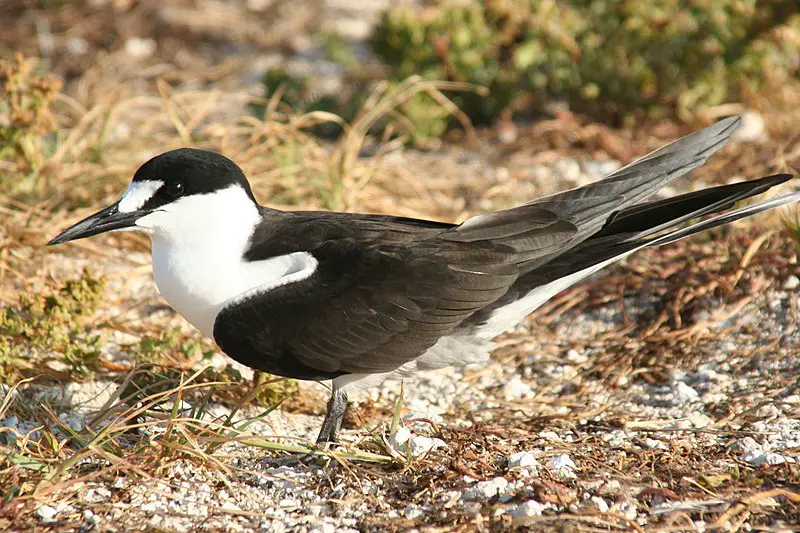
The Sooty Tern is a bird that lives in the tropics of all three major oceans. It is found mostly on remote islands where it returns to nest and breed during its seasonal journeys.
This member of the Laridae family has been described by Carl Linnaeus as Sterna fuscata, though more recently it was given its current name Onychoprion fuscatus.
The sooty tern has dark grey wings and back, with white underneath for camouflage against predators when flying over open ocean waters; they are also adept at diving underwater in search of food such as fish or crustaceans which make up their diet.
They live in colonies and usually lay two eggs each year which incubate for about four weeks before hatching into fluffy little chicks.Scientific classification:
| Kingdom | Animalia |
| Phylum | Chordata |
| Class | Aves |
| Order | Charadriiformes |
| Family | Laridae |
| Genus | Onychoprion |
| Species | O. fuscatus |
Also Featured In: Maldives birds, Birds That Live in Ascension Island
10. White Tern
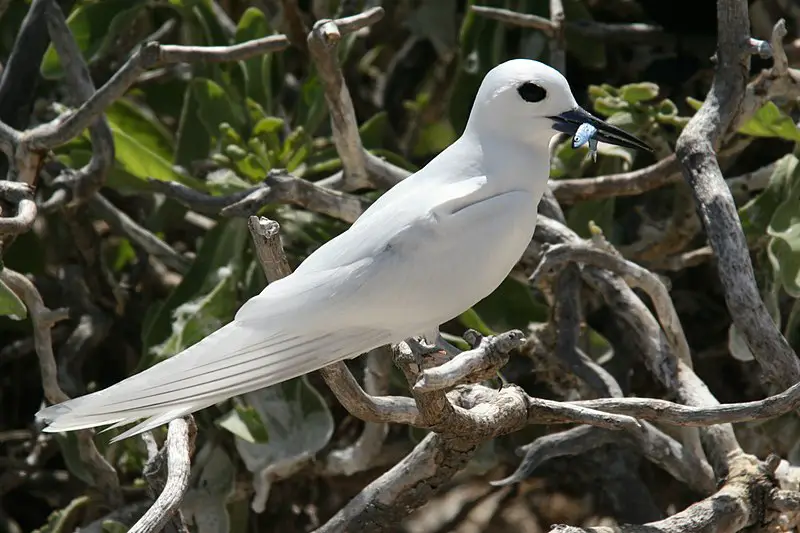
The White tern, also known as the common white tern or Fairy Tern, is a small seabird species found across tropical oceans all over the world.
Known for its elegance and beauty by humans and other animals alike, these birds are truly mesmerizing with their snow-white feathers.
They can be seen soaring in high altitudes or circling around ships at sea looking for food. The Hawaiian name ‘manu-o-Kū’ translates to ‘bird of heaven’ which reflects how majestic this bird looks when it flies through the sky.
These lovely creatures often breed on isolated islands away from predators along with another smaller species called Little White Terns (Gygis microrhyncha).Scientific classification:
| Kingdom | Animalia |
| Phylum | Chordata |
| Class | Aves |
| Order | Charadriiformes |
| Family | Laridae |
| Genus | Gygis |
| Species | G. alba |
Also Featured In: Seychelles birds, White Oahu Birds
11. Great Frigatebird
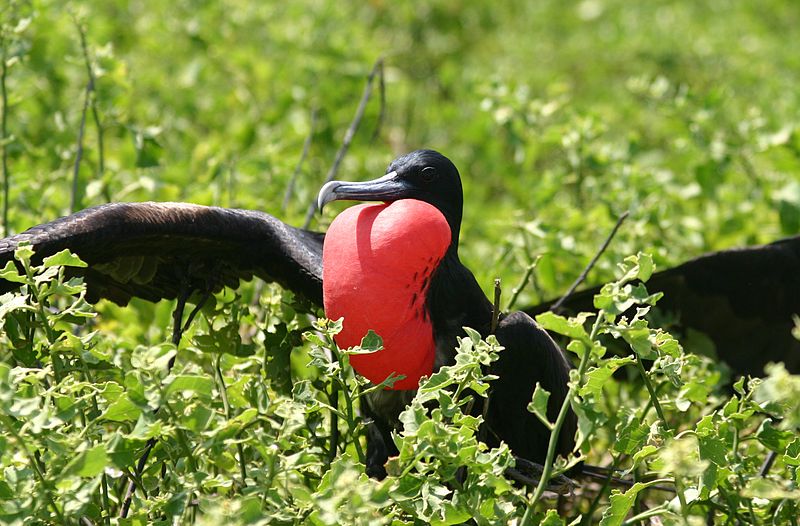
The Great Frigatebird is a large seabird found in tropical regions of the Pacific and Indian Oceans, as well as the South Atlantic.
It can grow up to 105 cm long with black plumage, making it one of the largest frigatebirds around.
The species also exhibits sexual dimorphism; males have bright red throat pouches while females have white or grey ones instead.
These birds nest in colonies on islands or near coastal areas where they feed off fish schools, squid and other marine life that they snatch from their dive-bombing prey.
They are highly adept at soaring for hours above oceanic waters searching for food sources below them before dives down into shallow water to catch unsuspecting meals.Scientific classification:
| Kingdom | Animalia |
| Phylum | Chordata |
| Class | Aves |
| Order | Suliformes |
| Family | Fregatidae |
| Genus | Fregata |
| Species | F. minor |
Also Featured In: Christmas Island Birds, Birds of Galápagos Islands You Need to Know
12. Laysan Albatross
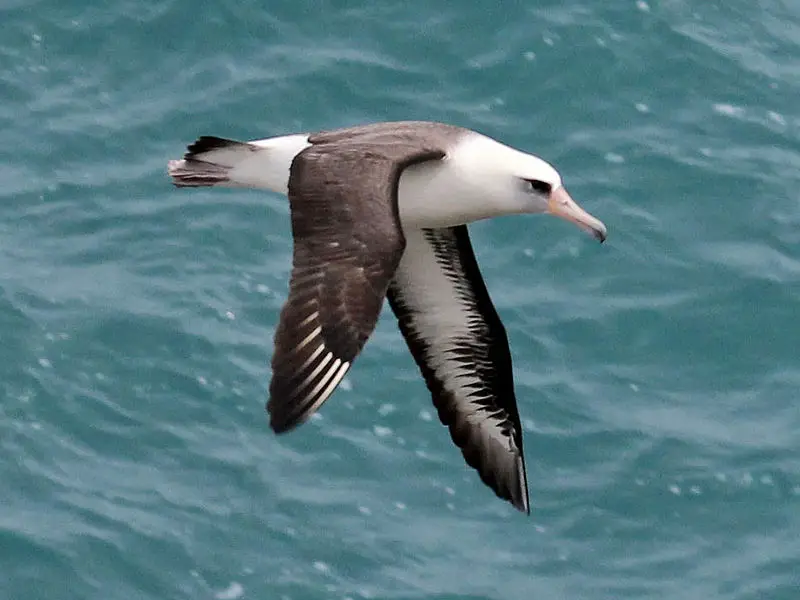
The Laysan albatross is a large seabird found in the North Pacific Ocean. Most of its population (99.7%) can be seen residing in the Northwestern Hawaiian Islands, where they form strong colonies and thrive among their natural habitat there.
They are small for an albatross but still have distinguishable features such as long wingspans that help them soar gracefully above oceans while searching for food over great distances with ease.
It’s estimated to have 1.18 million birds worldwide and continues to expand or re-expand its range throughout other areas of the oceanic region too.Scientific classification:
| Kingdom | Animalia |
| Phylum | Chordata |
| Class | Aves |
| Order | Procellariiformes |
| Family | Diomedeidae |
| Genus | Phoebastria |
| Species | P. immutabilis |
Also Featured In: Albatross Species, Birds You’ll Find in the Sea
13. Black-Footed Albatross
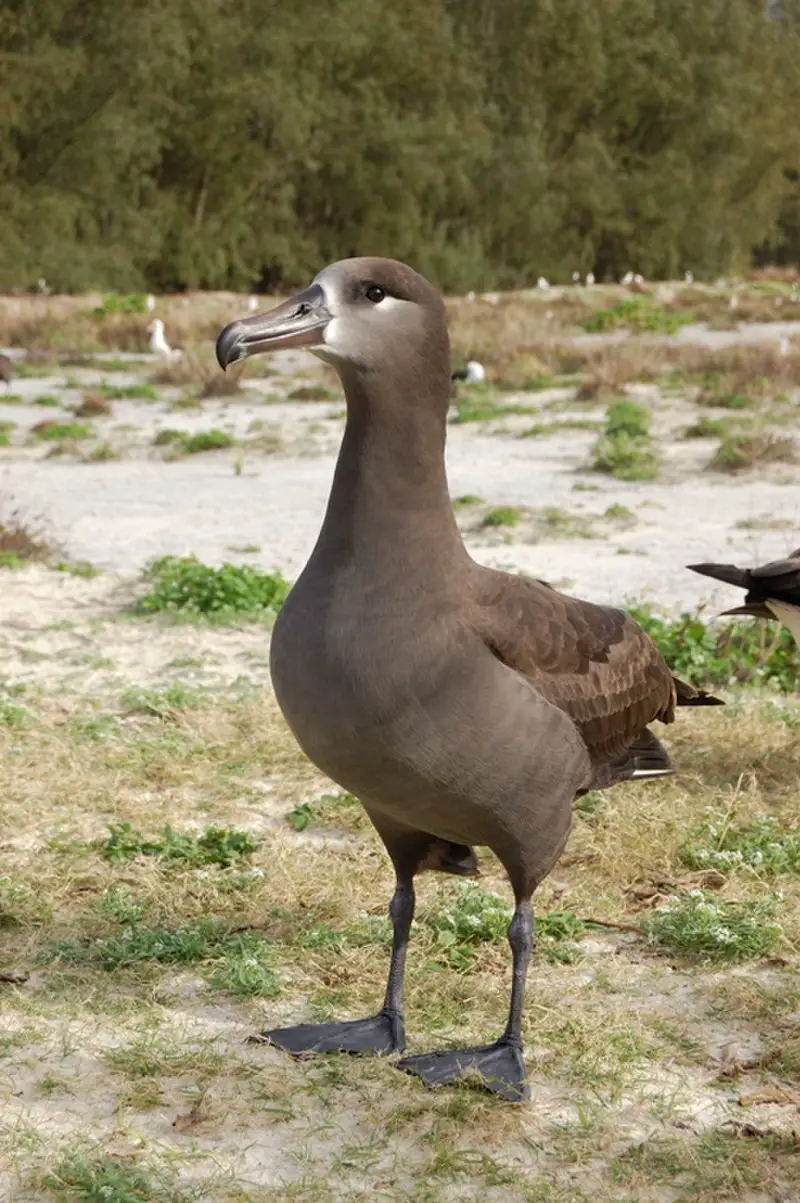
The black-footed albatross is a species of large seabird from the Diomedeidae family, found primarily in North Pacific coastal areas.
It is one of three species of northern hemisphere albatrosses and has dark plumage unlike many others.
These birds are mostly located around the Northwestern Hawaiian Islands where they nest on isolated tropical islands.
The population numbers have been rapidly declining due to human activities such as fishing nets and plastic waste consumption which affects their food sources.
Conservation efforts must be made to protect these majestic creatures before it’s too late.Scientific classification:
| Kingdom | Animalia |
| Phylum | Chordata |
| Class | Aves |
| Order | Procellariiformes |
| Family | Diomedeidae |
| Genus | Phoebastria |
| Species | P. nigripes |
Also Featured In: Birds that Live in the Ocean , Most Common Oahu Birds
14. Sternidae
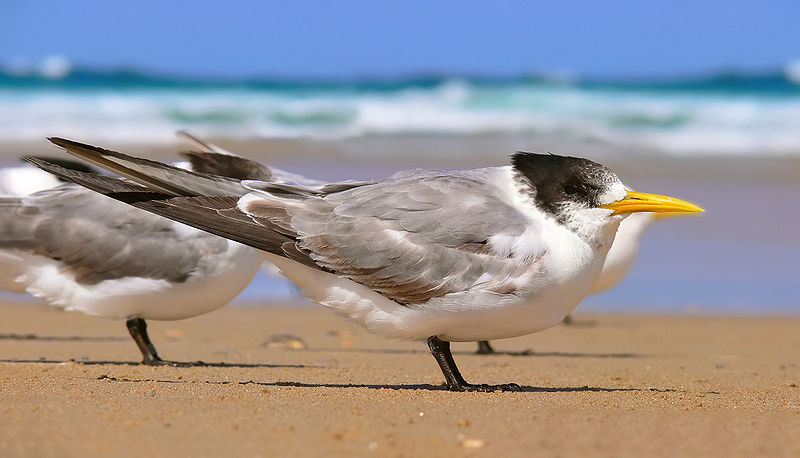
Sternidae are a subgroup of the family Laridae, consisting of eleven genera. They have slender bodies with long forked tails and narrow wings. Their bills are long and their legs relatively short.
Most species display pale grey or white plumage above, while underneath they show black markings on the head along with varying shades of browns elsewhere on their body.
These seabirds can be found in coastal areas near oceans, rivers and wetlands worldwide but especially in North America where they feed primarily on small fish which they capture by swooping down from the air to snatch them up from below the surface.
They also supplement this diet with crustaceans such as crabs when available.Scientific classification:
| Kingdom | Animalia |
| Phylum | Chordata |
| Class | Aves |
| Order | Charadriiformes |
| Family | Laridae |
| Subfamily | Sterninae Bonaparte, 1838 |
Also Featured In: Florida Birds, Water Birds Live around Us
15. ʻApapane
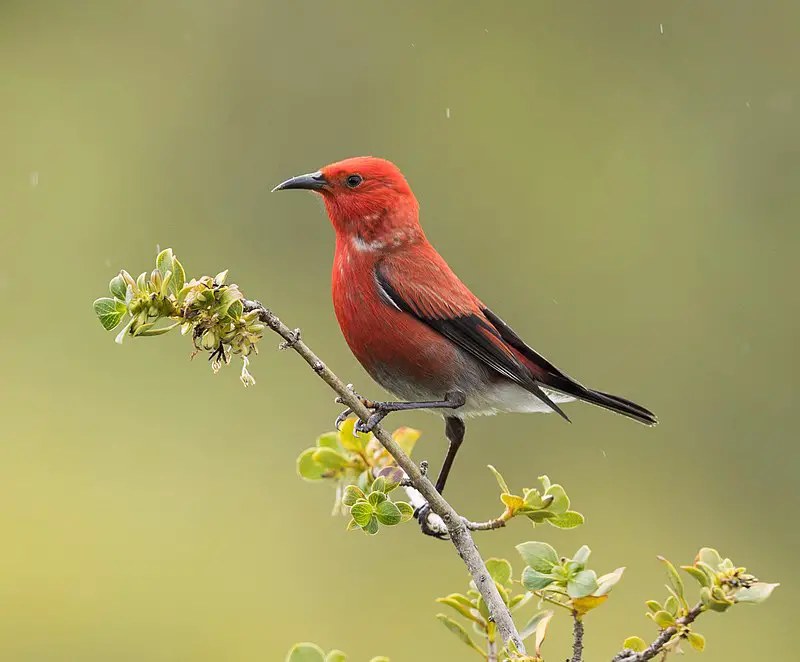
The ‘Apapane is a beautiful bird native to the Hawaiian Islands. It has bright crimson feathers and is a member of the honeycreeper family.
This small species can be found on all main islands, including Hawaiʻi, Maui, Lānaʻi, Kauaʻi, Molokaʻi and Oahu.
These birds are most commonly seen in ōhi’a trees where they feed off nectar from flowers as well as insects that live among the foliage.
They nest high up in these tall hardwood trees and also soar through rainforest treetops looking for food sources with their long wingspan.
The ‘Apapane’s vibrant coloration makes it an iconic symbol of Hawaii’s diverse wildlife landscape; its cheerful presence often bringing joy to visitors who have come to explore this tropical paradise.Scientific classification:
| Kingdom | Animalia |
| Phylum | Chordata |
| Class | Aves |
| Order | Passeriformes |
| Family | Fringillidae |
| Subfamily | Carduelinae |
| Genus | Himatione |
| Species | H. sanguinea |
Also Featured In: Hawaii Birds, Birds of Kauai, Hawaii
16. Cinnamon Teal
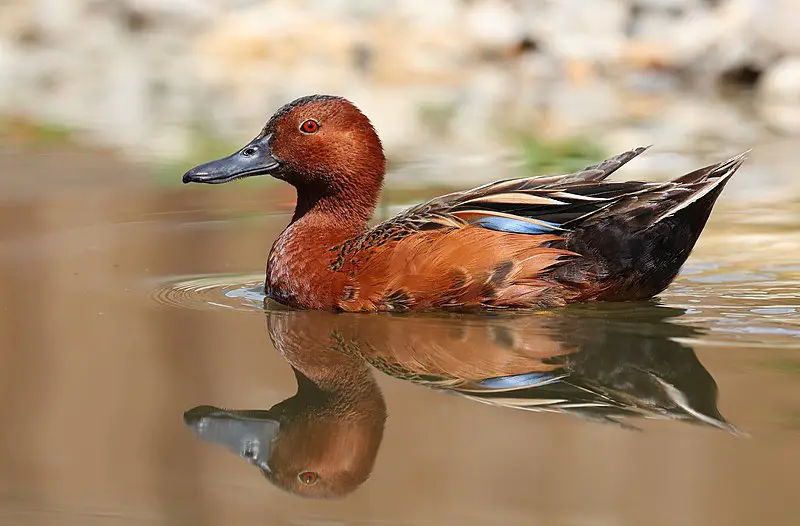
The Cinnamon Teal is a species of duck found in western North and South America. The males are bright reddish-brown while the female’s plumage is duller brown.
They inhabit marshes and ponds, feasting on plants–mainly seeds, roots, stems and leaves. Both genders have dark bills but it’s the male that stands out with its cinnamon-red head & body as well as red eye.
For nesting they prefer areas near shallow water where there are plenty of aquatic vegetation – often making their nests among grasses or cattails to conceal themselves from predators like foxes & raccoons.
These impressive birds also migrate during springtime; travelling far distances across open waters between continents – an incredible feat for such small creatures.Scientific classification:
| Kingdom | Animalia |
| Phylum | Chordata |
| Class | Aves |
| Order | Anseriformes |
| Family | Anatidae |
| Genus | Spatula |
| Species | S. cyanoptera |
Also Featured In: birds of Wyoming, Most Common Lake Birds
17. Bufflehead
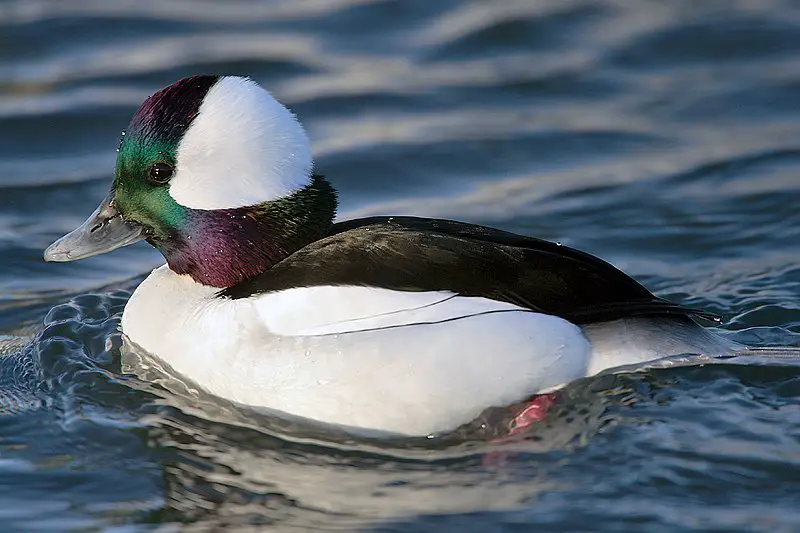
The Bufflehead bird is a small sea duck belonging to the goldeneyes genus. It was first described in 1758 by Carl Linnaeus, and its scientific name is Bucephala albeola.
The name “Bucephala” comes from the Greek words for “bull-headed,” which refers to its oddly shaped, bulbous head.
These birds are known for their striking black and white plumage, with the males sporting distinctive iridescent green and purple feathers on their heads.
Buffleheads are found primarily in North America, spending their winters on coastal waters and migrating inland to breed in wooded areas.
They are skilled divers and feed primarily on insects and small crustaceans. Despite their small size, Buffleheads are hardy birds and can survive in extreme weather conditions.Scientific classification:
| Kingdom | Animalia |
| Phylum | Chordata |
| Class | Aves |
| Order | Anseriformes |
| Family | Anatidae |
| Genus | Bucephala |
| Species | B. albeola |
Also Featured In: Estuaries Birds, Acadia National Park Birds
18. Bristle-Thighed Curlew
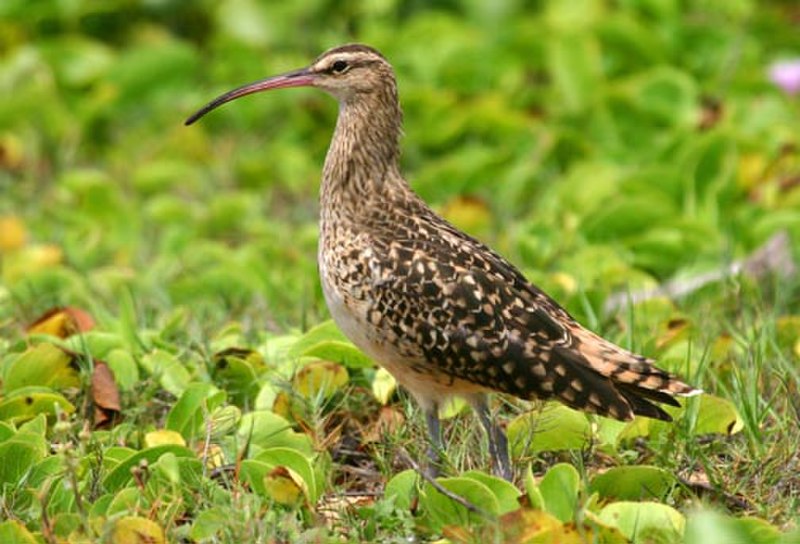
The Bristle-thighed curlew is a medium-sized shorebird that can be found breeding in Alaska. During the winter, this bird migrates to tropical Pacific islands.
It is called kivi or kivikivi in Mangareva and kihi in Rakahanga. Interestingly, it is believed that the bird may have influenced the name of the New Zealand flightless bird, the kiwi.
However, some linguists have proposed an alternate origin for the name. Despite its small size, the Bristle-thighed curlew is a formidable bird, known for its long legs and curved bill, which it uses to probe the sand for food.
It is a distinct and important species, facing threats from habitat loss and disturbance during migration and breeding. Conservation efforts are underway to protect this unique and remarkable bird.Scientific classification:
| Kingdom | Animalia |
| Phylum | Chordata |
| Class | Aves |
| Order | Charadriiformes |
| Family | Scolopacidae |
| Genus | Numenius |
| Species | N. tahitiensis |
Also Featured In: Birds Live In Spit Island,
19. Laysan Finch
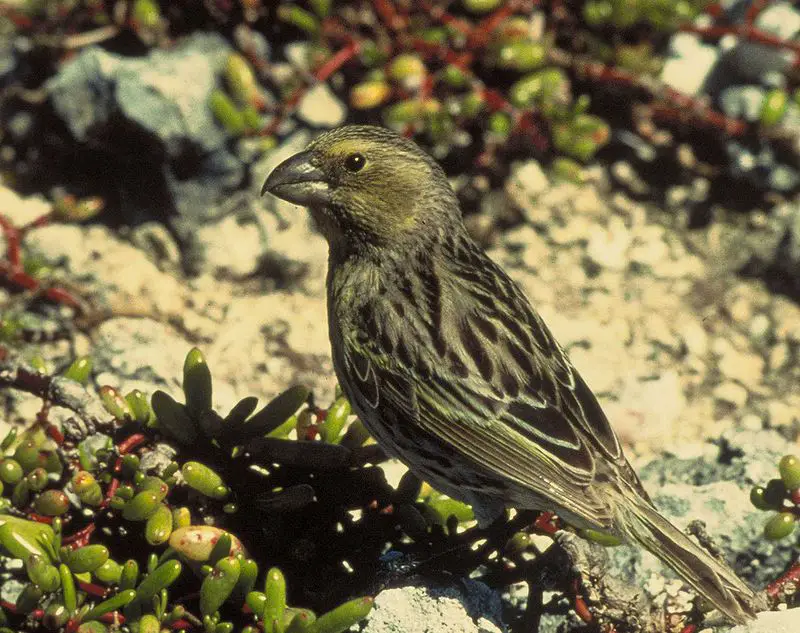
The Laysan finch is a bird endemic to the Northwestern Hawaiian Islands. It belongs to the Hawaiian honeycreeper family and is closely related to the Nihoa finch.
Named after the island it was first discovered on, the Laysan finch was later introduced to a few other atolls. This species is one of only four remaining finch-billed Hawaiian honeycreepers.
Despite its small size, it is a hardy bird that has managed to adapt and survive in a challenging environment.
The Laysan finch is a valuable part of Hawaii’s ecosystem and its preservation is important for the continued health and biodiversity of the islands.Scientific classification:
| Kingdom | Animalia |
| Phylum | Chordata |
| Class | Aves |
| Order | Passeriformes |
| Family | Fringillidae |
| Subfamily | Carduelinae |
| Genus | Telespiza |
| Species | T. cantans |
Also Featured In: Birds That Live In Laysan Island, Common Birds of Kauō